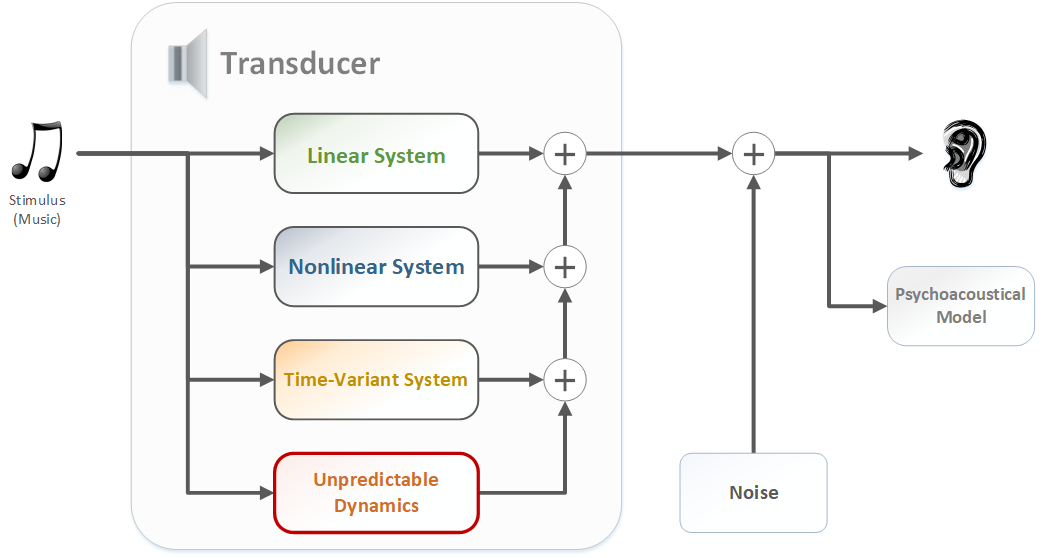Auralization
What is Auralization?
“Auralization” is the process of generating a virtual audio signal where signal components, that are of special interest, are enhanced. These signals may be used for a subjective and objective evaluation.
To decompose the signal components, physical modeling, measurement and system identification techniques may be used. Different techniques allow separation of distinct components. A loudspeaker system may be described with linear (e.g. crossover), nonlinear (e.g. Bl(x), Kms(x)) and time-dependent (e.g. heating) systems. Those systems introduce regular distortions. In addition, unpredictable (irregular) distortion may be generated by the loudspeaker, for example due to a defect. Performing a measurement will also add noise (e.g. rolling and propulsion noise) to the measured signal.
With Klippel auralization, regular and irregular nonlinear distortion components can be scaled in the output signal. Using these “virtual” loudspeakers, listening tests may be designed to evaluate design choices from the customers point of view (or “hear”). By applying those signals to a perceptual model (PEQ), the impact on the perceived sound quality can be predicted. The performance-cost ration may be tuned to an optimum while the number of built prototypes is reduced.
Overview
| Characteristics | KLIPPEL R&D System | KLIPPEL QC System |
|---|---|---|
| Regular distortion of the loudspeaker system | SIM-AUR, DIF-AUR1, AUR2 | |
| Irregular distortion due to defects | DIF-AUR1 | SPL |
| Voice coil displacement | SIM-AUR1, AUR2 | |
| Voice coil temperature | SIM-AUR1, AUR2 | |
| Pole-tip, magnet temperature | SIM-AUR | |
| Voltage, current and input power | SIM-AUR1, AUR2 | |
| Sound pressure output | SIM-AUR | SPL |
| Modification of loudspeaker parameters | SIM-AUR |
1Feature currently in development
2Deprecated
Klippel R&D System
| Module | Comment |
|---|---|
Simulation Auralization | The SIM-AUR module performs large signal simulation and auralization of a virtual transducer. All parameters can be changed, to investigate their effect in the target application. In addition, a dynamic thermal modelling allows to predict the heating of the speaker based on the input signal. It supports input of arbitrary wave files, and can be run without the need of a Klippel Analyzer device. |
Difference Auralization | The DIF-AUR module separates the distortion by calculating the difference signal between a test signal and a reference signal after adjusting the gain and time delay of both signals. This auralization technique requires no transducer modelling but can also be applied for recording the output of device under test (DUT) in the small signal domain (reference) and in the large signal domain (test). This is important for auralizing distortion generated by nonlinear cone vibration and impulsive distortion generated by a rubbing voice coil, buzzing doors, loose particles and other defects. Note: This module is deprecated. Please contact support(at)klippel(dot)de for details and potential new products in our pipeline. |
| AuralizationModule (AUR) | AUR performs a large signal simulation and auralization of one drive unit in a two-way loudspeaker system. Note: This module is deprecated. Use the SIM-AUR instead. |
Standards
Audio Engineering Society
AES2 Recommended practice Specification of Loudspeaker Components Used in Professional Audio and Sound Reinforcement
International Electrotechnical Commission
IEC 60268-5 Sound System Equipment, Part 5: Loudspeakers
Other Related Tests
DC displacement – dynamic offset the voice coil
Harmonic distortion
Compression of fundamental components
Separated loudspeaker distortion
Multi-tone distortion
Intermodulation distortion
Transducer nonlinearities (curve shape)
Rub & Buzz and impulsive distortion
Transducer nonlinearities (curve shape)
Single-valued nonlinear parameters
Typical Test Objects
Papers and Preprints
W. Klippel, “Speaker Auralization – Subjective Evaluation of Nonlinear Distortion,” presented at the 110th Convention of the Audio Eng. Soc., Amsterdam, May 12-15, 2001, Preprint 5310, J. of Audio Eng. Soc., Volume 49, No. 6, 2001 June, P. 526. (abstract)
W. Klippel, Tutorial “Loudspeaker Nonlinearities - Causes, Parameters, Symptoms,” J. of Audio Eng. Soc. 54, No. 10, pp. 907-939 (2006 Oct.).

